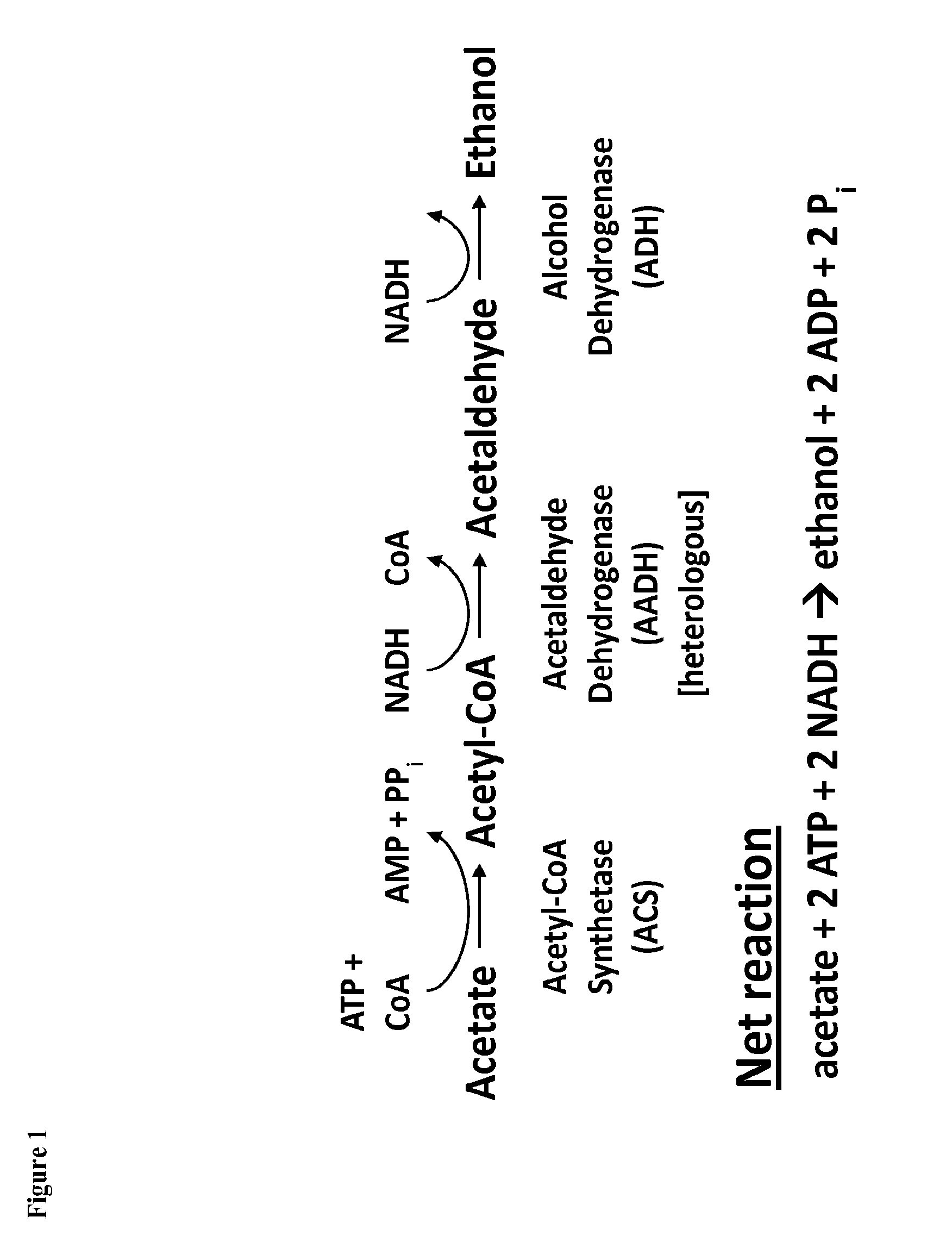Method for Acetate Consumption During Ethanolic Fermentation of Cellulosic Feedstocks
a cellulosic feedstock and ethanolic fermentation technology, applied in biofuels, biochemical apparatus and processes, enzymes, etc., can solve the problems of limiting the cellular energy that can be directed, the absence of low-cost technology for overcoming the recalcitrance of these materials, and the historically proven problem of hydrolysis
- Summary
- Abstract
- Description
- Claims
- Application Information
AI Technical Summary
Benefits of technology
Problems solved by technology
Method used
Image
Examples
example 1
[0288]The present prophetic example describes engineering of a recombinant microorganism to increase flux through the oxidative pentose phosphate pathway (PPP) by creating a redox imbalance in xylose consumption using xylose reductase (XR) and xylitol dehydrogenase (XDH) that is coupled with the conversion of acetate to ethanol or isopropanol.
[0289]Current methods rely on xylose isomerase to enable S. cerevisiae to consume xylose. An alternative pathway that uses XR and XDH has been studied in the scientific literature, but achieving efficient ethanol production using this method has been difficult because of the pathway's redox imbalance. See Watanabe, S. et al., “Ethanol production from xylose by recombinant Saccharomyces cerevisiae expressing protein engineered NADP+-dependent xylitol dehydrogenase,”J. Biotechnol. 130:316-19 (2007). XRs typically have a higher affinity for the cofactor NADPH, whereas most XDHs are NAD-specific. See Watanabe, S. et al., (2007).
[0290]Recently an ac...
example 2
[0305]The present example describes engineering of a recombinant microorganism to increase flux through the oxidative pentose phosphate pathway (PPP) by overexpressing pathway genes or reducing the expression of competing pathways that is coupled with the conversion of acetate to ethanol or isopropanol.
[0306]The strategy of Example 1 relies on two redox imbalanced pathways that counterbalance each other. An alternative approach is to improve the kinetics of the oxidative branch of the PPP over those of competing pathways. This is achieved by various approaches, including directly increasing the expression of the rate-limiting enzyme(s) of the oxidative branch of the PPP pathway, such as glucose-6-P dehydrogenase (encoded endogenously by ZWF1, SEQ 11) NO:23), changing the expression of regulating transcription factors like Stb5p (also referred to as Stb5) (Cadiére, A., et al., “The Saccharomyces cerevisiae zinc factor protein Stb5p is required as a basal regulator of the pentose phos...
example 3
[0340]The present prophetic example describes engineering of a recombinant microorganism to use the ribulose-monophosphate pathway (RuMP) for production of electron donors to be used in the conversion of acetate to ethanol or isopropanol.
[0341]Instead of relying on the endogenous oxidative branch of the PPP as described in Example 2, the heterologous RuMP pathway found in various bacteria and archaea, including Bacillus subtilis, Methylococcus capsulatus, and Thermococcus kodakaraensis, which also produces CO2 while conferring electrons to redox carriers, can be introduced. See Yurimoto, H., et al., “Genomic organization and biochemistry of the ribulose monophosphate pathway and its application in biotechnology,”Appl. Microbiol. Biotechnol. 84:407-416 (2009).
[0342]This pathway relies on the expression of two heterologous genes, 6-phospho-3-hexuloisomerase (PHI) and 3-hexulose-6-phosphate synthase (HPS). Examples of PHI and HPS enzymes include Mycobacterium gastri rmpB and Mycobacter...
PUM
| Property | Measurement | Unit |
|---|---|---|
| temperature | aaaaa | aaaaa |
| temperature | aaaaa | aaaaa |
| of energy | aaaaa | aaaaa |
Abstract
Description
Claims
Application Information
 Login to View More
Login to View More - R&D
- Intellectual Property
- Life Sciences
- Materials
- Tech Scout
- Unparalleled Data Quality
- Higher Quality Content
- 60% Fewer Hallucinations
Browse by: Latest US Patents, China's latest patents, Technical Efficacy Thesaurus, Application Domain, Technology Topic, Popular Technical Reports.
© 2025 PatSnap. All rights reserved.Legal|Privacy policy|Modern Slavery Act Transparency Statement|Sitemap|About US| Contact US: help@patsnap.com



